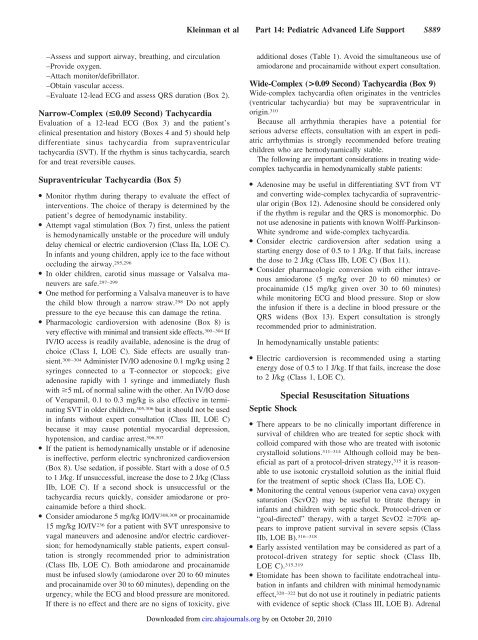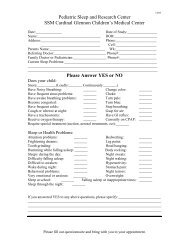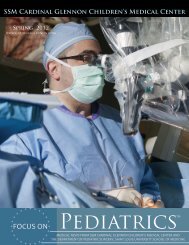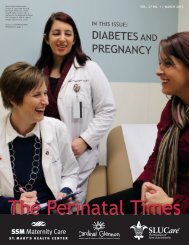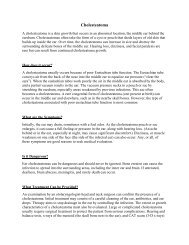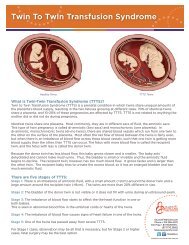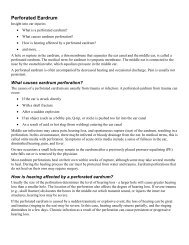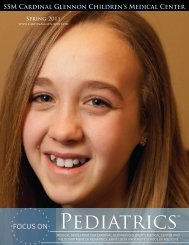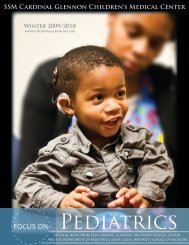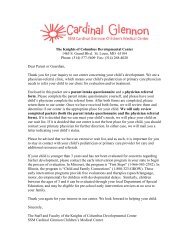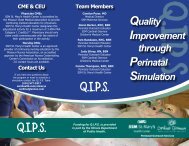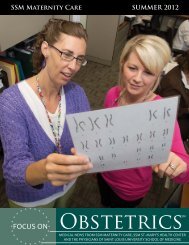pediatric-ALS-AHA-guidelines-circulation_11-2010 - SSM Cardinal ...
pediatric-ALS-AHA-guidelines-circulation_11-2010 - SSM Cardinal ...
pediatric-ALS-AHA-guidelines-circulation_11-2010 - SSM Cardinal ...
You also want an ePaper? Increase the reach of your titles
YUMPU automatically turns print PDFs into web optimized ePapers that Google loves.
Kleinman et al Part 14: Pediatric Advanced Life Support S889–Assess and support airway, breathing, and <strong>circulation</strong>–Provide oxygen.–Attach monitor/defibrillator.–Obtain vascular access.–Evaluate 12-lead ECG and assess QRS duration (Box 2).Narrow-Complex (0.09 Second) Tachycardia (Box 9)Wide-complex tachycardia often originates in the ventricles(ventricular tachycardia) but may be supraventricular inorigin. 310Because all arrhythmia therapies have a potential forserious adverse effects, consultation with an expert in <strong>pediatric</strong>arrhythmias is strongly recommended before treatingchildren who are hemodynamically stable.The following are important considerations in treating widecomplextachycardia in hemodynamically stable patients:● Adenosine may be useful in differentiating SVT from VTand converting wide-complex tachycardia of supraventricularorigin (Box 12). Adenosine should be considered onlyif the rhythm is regular and the QRS is monomorphic. Donot use adenosine in patients with known Wolff-Parkinson-White syndrome and wide-complex tachycardia.● Consider electric cardioversion after sedation using astarting energy dose of 0.5 to 1 J/kg. If that fails, increasethe dose to 2 J/kg (Class IIb, LOE C) (Box <strong>11</strong>).● Consider pharmacologic conversion with either intravenousamiodarone (5 mg/kg over 20 to 60 minutes) orprocainamide (15 mg/kg given over 30 to 60 minutes)while monitoring ECG and blood pressure. Stop or slowthe infusion if there is a decline in blood pressure or theQRS widens (Box 13). Expert consultation is stronglyrecommended prior to administration.In hemodynamically unstable patients:● Electric cardioversion is recommended using a startingenergy dose of 0.5 to 1 J/kg. If that fails, increase the doseto 2 J/kg (Class 1, LOE C).Special Resuscitation SituationsSeptic Shock● There appears to be no clinically important difference insurvival of children who are treated for septic shock withcolloid compared with those who are treated with isotoniccrystalloid solutions. 3<strong>11</strong>–314 Although colloid may be beneficialas part of a protocol-driven strategy, 315 it is reasonableto use isotonic crystalloid solution as the initial fluidfor the treatment of septic shock (Class IIa, LOE C).● Monitoring the central venous (superior vena cava) oxygensaturation (ScvO2) may be useful to titrate therapy ininfants and children with septic shock. Protocol-driven or“goal-directed” therapy, with a target ScvO2 70% appearsto improve patient survival in severe sepsis (ClassIIb, LOE B). 316–318● Early assisted ventilation may be considered as part of aprotocol-driven strategy for septic shock (Class IIb,LOE C). 315,319● Etomidate has been shown to facilitate endotracheal intubationin infants and children with minimal hemodynamiceffect, 320–322 but do not use it routinely in <strong>pediatric</strong> patientswith evidence of septic shock (Class III, LOE B). AdrenalDownloaded from circ.ahajournals.org by on October 20, <strong>2010</strong>


